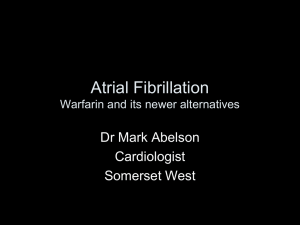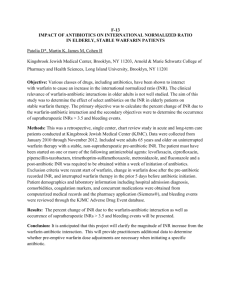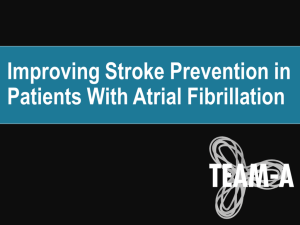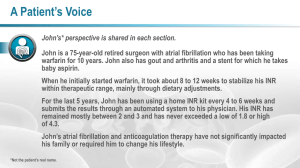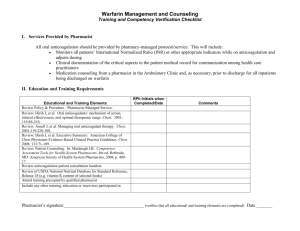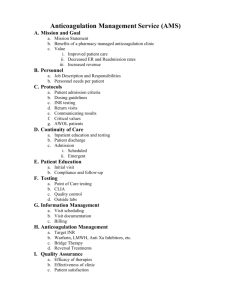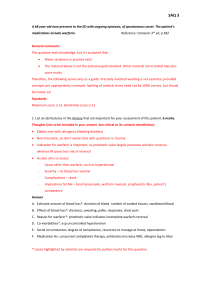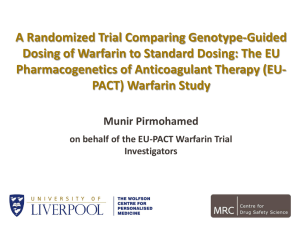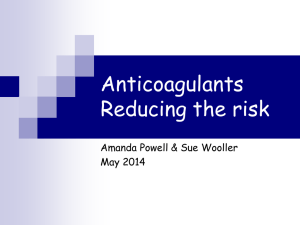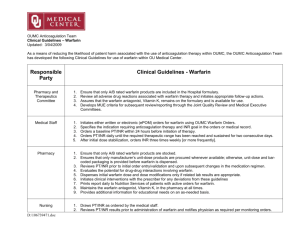Document
advertisement
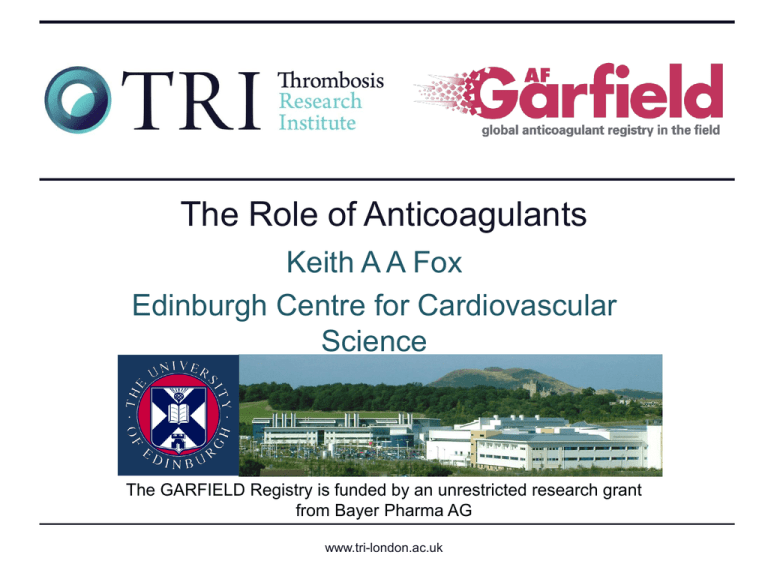
The Role of Anticoagulants Keith A A Fox Edinburgh Centre for Cardiovascular Science The GARFIELD Registry is funded by an unrestricted research grant from Bayer Pharma AG www.tri-london.ac.uk Disclosure Statement Keith A. A. Fox • President of the British Cardiovascular Society 2009-2012 • European Society of Cardiology: ESC Programme Chair 20122014 • – KAA Fox member of the ESC guidelines group: ESC Guidelines: Non-ST elevation ACS EHJ (2007) 28, 1598–1660 ESC Guidelines: ST Elevation MI EHJ (2008) 29: 2909-2945 – • • • • Co-Chair ROCKET-AF, Steering Committee Major funding: British Heart Foundation, Medical Research Council and the Wellcome Trust Additional funding: Bayer, Janssen, Sanofi, Lilly, Astra Zeneca No stock ownership Untreated and Under-treated Patients • Clear need to: – Identify patients with unsuspected AF and stroke risk – Anticoagulate those at stroke risk – Improve adherence to anticoagulation – Aspirin is not an adequate therapy for stroke prevention in AF Lowest Effective Intensity for Warfarin Therapy Odds Ratio 15 INR 2.0 1.7 1.5 1.3 10 5 3 1 1.0 1.5 2.0 3.0 4.0 Odds Ratio 1.0 2.0 3.3 6.0 7.0 INR INR below 2.0 results in a higher risk of stroke Hylek EM, et al. An analysis of the lowest effective intensity of prophylactic anticoagulation for patients with non-rheumatic atrial fibrillation. N Engl J Med. 1996;335:540-546. Risk of Intracranial Haemorrhage (Outpatients) 11.2 18.2 2.3 2.7 10 Odds Ratio 8 PTR above 2.0 increases the risk of bleeding The odds ratio of subdural hemorrhage increased 7.6 fold as the PTR increased from 2.0 to 2.5 6 4 2 0 0 1.4 1.6 1.8 2 Prothrombin Time Ratio Hylek EM, and Singer DE. Risk factors for intracranial hemorrhage in outpatients taking warfarin. Ann Intern Med. 1994;120:897-902. Warfarin vs Antiplatelet Agents Systematic Overview 4.5 million people with AF in the EU Hart RG, et al. Ann Intern Med. 2007;146:857-867. Problems With Vitamin K-Based Oral Anticoagulation • Risk of bleeding – Many contra-indications • • • • • Narrow therapeutic window Frequent blood testing Many drug interactions Discontinuations for surgery/procedures Lifestyle restrictions Finding the right balance is key! Stroke and ACS Risk Bleeding Risk The Dutch Bypass Oral Anticoagulants Study: Distribution of Time in Each INR Range Time in INR Class (patient-years) 450 RANGE 50% 400 350 300 250 200 150 100 50 0 1 1.5 2 2.5 3 3.5 4 INR 4.5 5 5.5 Dutch bypass OA vs ASA. Lancet. 2000;355:346-351. 6 6.5 >6.5 Tolerability of Warfarin During First Year of Therapy Elderly Patients in the US Major bleeding event Taken off therapy Rate (per 100 personyears) Rate (per 100 personyears) 0 3.1 15.6 1 4.3 17.1 2 2.0 12.9 3 19.5 32.6 ≥4 23.4 32.1 CHADS2 score • 58% time in therapeutic range • Major haemorrhage 7.2%; ICH 2.5% – Rates were 2.75× higher in patients ≥80 years • 28% of patients discontinued warfarin at 1 year Hylek EM, et al. Circulation. 2007;115:2689-2696. Time in Therapeutic Range (UK) n=2,074,928 INRs in Primary Care http://www.4s-dawn.com/products/anticoagulation/dawn-ac-benchmarking-service/ Targets for Anticoagulants ORAL DIRECT PARENTERAL TF/VIIa X IX VIIIa IXa Fondaparinux Va Rivaroxaban Xa Apixaban LMWH Edoxaban II Dabigatran AZD 0837 INDIRECT UFH IIa Fibrinogen Weitz JI, Bates SM. J Thromb Haemost. 2005;3:1843-1853. Weitz JI, et al. Chest. 2008;133:234-256. Fibrin 12 NOACs vs Warfarin: Trial Summary Outcome RE-LY1 Dabigatran 150 mg vs Warfarin RR (95% CI) ROCKET AF2 Rivaroxaban vs Warfarin RR (95% CI) ARISTOTLE3 Apixaban vs Warfarin RR (95% CI) ENGAGE AF4 Edoxaban* 60 mg vs Warfarin HR (95% CI) Stroke or SE 0.65 (0.52-0.81) P <.001 0.79 (0.66-0.96) P <.001 0.79 (0.66-0.95) P =01 0.79 (0.63–0.99) P <.001 Death from any cause 0.88 (0.77-1.00) P =.051 0.85 (0.70, 1.02) 0.073 0.89 (0.80-0.998) P =.047 0.92 (0.83-1.01) P =.08 Intracranial hemorrhage 0.40 (0.27-0.60) P <.001 0.67 (0.47-0.93) P =.02 0.42 (0.30-0.58) P <.001 0.47 (0.34-0.63) P <.001 Trial group size Dabig 150: 6076 W: 6022 Riva: 7131† W: 7133 Apix: 9120 W: 9081 Edox 60mg: 7035 W: 7036 NB: trial populations differ in characteristics Connolly SJ, et al. N Engl J Med. 2009;361:1139-1151.[1] Patel MR, et al. N Engl J Med. 2011;365:883-891.[2] Granger CB, et al. N Engl J Med. 2011;365:981-992.[3] Giugliano RP, et al. N Engl J Med. 2013;369:2093-2104.[4] * Edoxaban is not yet approved for stroke prevention in AF patients. † ITT population at baseline ESC 2012 Guidelines: All Novel OACs Preferred Over VKAs Based on Net Clinical Benefit Class* Level# I A IIa A Novel OACs in patients with VKA issues, e.g. unstable INR, VKA-related adverse events I B Novel OAC over VKA based on net clinical benefit for most patients with non-valvular AF IIa A Recommendations CHA2DS2-VASc ≥2 : VKA or novel OACs CHA2DS2-VASc = 1: VKA or novel OACs (except female patients <65 years with score = 1 based on gender) *Class of recommendation; #Level of evidence Camm AJ, et al. Eur Heart J. 2012;33:2719-2747. So, based on the evidence, what is the future….? • • • • • • • • Systematic detection of AF and stroke risk Improved patient education for compliance Registry programmes and quality control Reduced stroke risk, ICH and major complications with “NOACs” No need to routinely monitor Do we need antidotes? Yes, rarely New indications – AF and ACS, post ACS The NOACs will become the norm for anticoagulation
